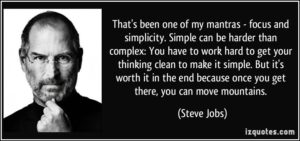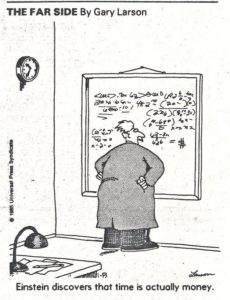Like it or not, sooner or later you are going to have to stand up in front of somebody, or maybe a group of somebodies, and convey some sort of information to them. This is called “presenting”. This event usually occurs when it is deemed that you know more about a certain topic than those in your audience do. Sometimes it is actually the case, and sometimes it is best to study hard and do some research beforehand so that again it can be the case. Regardless, how you perform on this stage, conveying information to other people, can determine a great deal regarding your opportunities to continue progressing in your business career.
Laurence J. Peter is the author of the book the “Peter Principle”. In it he states:
”…that people in a hierarchy tend to rise to their “level of incompetence”. In other words, employees are promoted based on their success in previous jobs until they reach a level at which they are no longer competent, as skills in one job do not necessarily translate to another.”
Understand that the ability to cogently present and convey information to others is a baseline, table stakes capability in business. If you are not good at it, you can assume that you are at your current level of incompetence and will remain there until your presentation skills improve.
Also understand that technical competence, or mastery of the topic is only part of the requirement for making successful presentations. In other words, you may know what you are talking about, but that doesn’t mean that you will be successful at getting your point across to others on the topic. I’ll try to go through a few items that you should keep in mind when you are presenting. Many should be obvious, however some maybe not so much so.
Who is your audience?
Believe it or not, this is important. Not everyone is going to be interested in what you have to say. Who are the people in the room that will be listening to you, and why are they there? Your presentation needs to match their expectations. Management will want general trends and overviews. Individual contributors may want more specifics. Sales, engineering and finance all have different expectations regarding the presentations they see. Sales wants to know how whatever you are talking about will help them sell more. If this aspect is not addressed, for them it will be wasted time. Likewise, finance will want to know about the costs, revenue, profitability of the topic. Telling them about how it will help them sell more will at best be only marginally acceptable.
What is the “Thesis Statement” for your presentation?
What is the purpose of your presentation? Why is this presentation important to them? Is it just to report on the progress of an internal company project? Is it a customer product or service presentation as part of an ongoing customer sales engagement? Are you trying to get management to agree to fund development of a new product?
The point here is that a presentation is usually used to convince somebody about something. Whether it is that progress is actually occurring on a project, or that your product is superior to the competition’s, you should have either a specific or implicit thesis, or reason for your presentation. This will help keep you on topic, and again it will help limit the amount of extraneous information that may try and creep into your presentation.
As Gary Larson has shown, time is money. People have only a certain amount of time that they can devote to certain activities. You may have the most import, or most interesting topic to talk about, but you will never have all the time that you will feel that you will need to be able to comfortably talk about it.
“One well-known formulation for PowerPoint presentations is the 10/20/30 rule. This rule dictates that you should use about ten slides for a twenty minute presentation, and each slide should utilize thirty point font. In other words, each slide should be about two minutes in length.”
https://www.wikihow.com/Choose-the-Right-Number-of-Slides-for-a-Powerpoint-Presentation
Needless to say, most presentations do not adhere to this information, and as such, most presentations today, in my opinion are often not very good. If you can’t say it succinctly in twenty to thirty minutes with ten to fifteen slides, at most, then you have too much non-critical information in your presentation. Be succinct.
Proof read your presentation. Several times.
With today’s spelling and grammatical checking capabilities, there is no excuse for misspelled words, improper grammar, improper punctuation or improper word usage (their, there, they’re).
End of story.
How can you be perceived as an expert, leader, or in this case imparter of information and wisdom if you cannot deliver the message free of mechanical errors. Having them undermines the intended message.
Simplify everything associated with your presentation.
Not everyone will have your level of knowledge regarding the topic. Specifically define any acronyms you may choose to use. You are presenting slides, not writing a book. Bulletize everything possible. It will help break up the slide. It will make it easier for the audience to follow. It will force you to be concise in what you say. Remember, you are not having a conversation. You are presenting.
Do not read your slides to the audience.
There is a very good chance that everyone in your audience can read. You don’t need to read to them.

“A picture is worth a thousand words” is an English language-idiom. It refers to the notion that a complex idea can be conveyed with just a single picture, this picture conveys its meaning or essence more effectively than a description does.
https://en.wikipedia.org/wiki/A_picture_is_worth_a_thousand_words
Convey the essence of your topic with the slide and let the verbal aspect of your presentation deliver any necessary specifics to fill in the story.
Unless you are specifically presenting a detailed topic, such as tabulated data, or specific engineering or performance metrics, etc, the less verbiage on a slide, the better. As I said, you can speak to the slide to impart the specifics. It also enables you to manipulate your time allotment by speaking more to certain slides and less to others, and still stay within your time allotment.
Respect other people’s time.

Be ready to start on time. Set the standard for answering any questions either during (interactive presenting) or at the end of the presentation. Do not run longer than your allotted time. There may be instances where the consensus is that you should take more time, depending on the topic and audience, but in general, you need to be prepared to finish within your allotted time.
As business continues to get more complex, it is many times an easy trap to fall into in making our presentations also more complex. We have the technical capabilities to edit and manipulate both data and image to the point where we can have far more data on a single slide than can either be presented or understood quickly. We continue to generate more complex data and then use more complex means to convey it.
It seems that both the amount of data per slide, and the number of slides per presentation continues to expand. It takes us longer and longer to present the information, and many times we end up spending time presenting to an audience that has a marginal interest in the topic to begin with.
Presentations of all types are an integral part of business. With the continued acceleration of the velocity of business, we need to be ever more mindful of both the time we spend presenting a topic, as well as the time we spend preparing the presentation on the topic. Shorter and more focused presentations are a far more preferable means to convey and convince than the seemingly more prevalent, long and detailed ones that appear to be in vogue today.
Expertise is more better displayed by making the complex simple and easy to understand than it is by making the presentation more complex, and longer, to match the topic.


